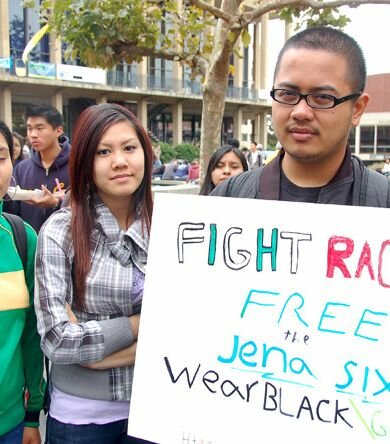Pursuing racial justice: A primer for young people
Featured — By Mikhail Lyubansky on February 10, 2010 at 07:48When it comes to activism, students often feel powerless. After all, they argue, they don’t have the ability to change rules, much less laws, or even influence how existing rules and laws are interpreted. Being students, which, by definition, means being in the process of learning rather than leading – they feel that few people take them seriously.
These concerns are not baseless. Most schools are hierarchical institutions, with students having relatively little formal power compared with school boards, administrators, and even teachers. At the same time, it is also true that each one of us has much more power than we might think. Here are four simple ways students can effectively contribute to the building of a racially just society.
Action #1: Be a Model
The old joke about how many psychologists it takes to change a light bulb (just one, but only if the light bulb wants to be changed) has a lot of truth to it. For the most part, people do not change unless they want to, and they usually don’t want to if someone makes them feel stupid or racist. Indeed, being called a “racist” in public is just about the most offensive insult imaginable because it carries an enormous social stigma and violates our self perception.
The reality is that few of us think of ourselves as stupid or racist, so when others even subtly suggest that we are, we tend to feel misunderstood and unfairly criticized. This, in turn, makes us want to defend our beliefs and good intentions or return the attack in some other way. Shaming, blaming and criticizing may satisfy our need to be punitive or to feel morally superior, but such actions almost never produce the kind of change in others that we claim we want.
And yet, there is no doubt that we do need to speak out against racism, because racism is maintained by our willingness to ignore it. Decades of research on conformity shows that when even a single person goes against the group norm, there is an opportunity for change. Speaking out against racism can be powerful, especially if a number of people coordinate their efforts. But, how do we do it in a way that actually accomplishes what we want and does not run the risk of increasing hostility or even breaking up a friendship?
For starters, keep away from the R-word, at least when referring to a person. Instead, speak out by sharing how something that someone did (e.g., tell a joke that pokes fun of a racial group) made you feel embarrassed or angry or hurt, so that others can recognize how their behavior might negatively impact others. Another approach to this particular situation might be to just say “that’s not funny.”
There is no one “right” way to handle these situations, but the idea is to not tolerate the behavior while, at the same time not rejecting or insulting the person doing it. The idea, based on principles of nonviolent communication (NVC), is to use power with, not power against. When we authentically state our needs and then make a specific request for a behavior change (for example, “please don’t tell those kinds of jokes in front of me”), success is not guaranteed, but the likelihood is greatly increased.
Action #2: Use Your Spheres
At the university where I currently work, there is a large system of fraternities and sororities that is almost entirely racially segregated. Many of my students, including those in my Psychology of Race and Ethnicity classes, are part of this system. By the middle of the semester, they are likely to notice the racial segregation and lament (in their personal weekly journals, which are required for class) that it exists. Yet, few students feel sufficiently empowered to try to create change, even within their own house. Social change may not come easy, but everyone has some influence, even students. In this particular case, the students have much more influence than I do as an outsider.
High school and elementary students have spheres of influence, too. These include family, friends, classmates, teammates and coworkers – even if it is at the corner McDonald’s – as well as people at church, school and a variety of other institutions. And, thanks to the internet and various social network apps, our social influence has no geographic boundaries. Sure, some goals may realistically be out of reach (put them aside until your sphere of influence reaches them), but If you sit down to map your own spheres of influence, you might be surprised at how powerful you really are. So set you sights, mobilize some like-minded friends, and get to it. It may not be easy and there are no guarantees of success, but as Theodore Roosevelt aptly put it, “the credit belongs to [those] who are actually in the arena.” [Image below courtesy of Ton Zijlstra]

Action #3: Join a Group
Speaking of friends, few people like being lone wolves. Even the most extreme introverts need to connect with others. Anti-racism work, like social justice work in general, is emotionally draining. Without a good support system, it is hard to sustain the energy. Besides, working with others is much more fun and efficient.
If you want to get involved in anti-racism work, join a group that is already doing it and don’t be shy about reaching out to groups whose membership is racially different than yours. It may seem intimidating at first, and it may take a little time to build up some trust, but trust-building of this sort part of the point. Below are links to a few national youth organizations. They’re not a bad place to start, but eventually you’ll want to connect with a local group, where you can form face-to-face relationships and collaborate on local projects. Groups like this exist in many communities. Just ask around. But if there really isn’t a local group interested in racial justice, find some kindred spirits in your social sphere and start one.




Action #4: Make Friends across Ethnic Lines
This is the advice students find most controversial. They think that I am suggesting they become friends with or date someone only because they are of a different ethnic background. I am not suggesting that at all. Friends and dating partners should be selected based on interpersonal attraction, which is influenced by a variety of different factors, including personality and shared interests.
Many of us, either deliberately or unconsciously, make choices that limit our opportunity to get to know people who we perceive as being different from us. Oftentimes, if we are White, we do not attend ethnic events or join ethnic organizations. And, if we identify with a particular ethnic group, we tend to stick to that group in a social context. We do this because we are afraid that we’d be unwelcome and uncomfortable. So, we self-segregate, sticking to our own group where we feel comfortable and understood, where our core beliefs and values and entire worldview go unchallenged.
But, what if we opened ourselves to the possibilities of developing real relationships (still based on interpersonal attraction, personality and/or shared interests) with people different from us? If we spend time with people, it just happens. And, that is really all I am advocating: put yourself in a position where you can spend time with people who are different from you and be open to connecting with them. The relationships that develop as a result may become some of the best you’ll ever have.
________________________
An earlier version of this article was published by ColorsNW, which is no longer in operation. For more racial analysis of news and popular culture, follow Mikhail on Twitter.
Tags: activism, adolescence, adolescents, anti-racism, college, friendships, high school, racial justice, racism, relationships, spheres of influence, students, teens, university, youthAuthor: Mikhail Lyubansky (24 Articles)

I'm a member of the teaching faculty in the department of psychology at the University of Illinois at Urbana-Champaign, where I teach, among other courses, The Psychology of Race and Ethnicity. My research and writing interests focus on immigration, racial/ethnic group relations and social justice. I write a blog about race and racial issues for Psychology Today. Please follow me on Twitter: http://www.twitter.com/mikhaill (@mikhaill)



 Share This
Share This Tweet This
Tweet This Digg This
Digg This Save to delicious
Save to delicious Stumble it
Stumble it





 Joel Stein, we are not laughing: The South Asian legal community responds
Joel Stein, we are not laughing: The South Asian legal community responds Precious... Really?
Precious... Really?







